Read the newspapers or follow ‘gaming Twitter’ and you’d be led to believe that children overspending on loot boxes is an industry-wide issue, that toxic behaviour online is ever present and that the games industry strides onwards with more influence and money than ever.
But while there’s truth in some of these, and certainly issues to be tackled in others, the stats don’t entirely back up all these prevalent narratives. This is shown in OFCOM’s Online Nation report, a deep dive into the UK’s gaming habits and how they’ve evolved since 2015, during the era of the live service game: popular genres, spending patterns and exposure to toxic behaviour. We take a look at the results.
AUDIENCE APPRECIATION
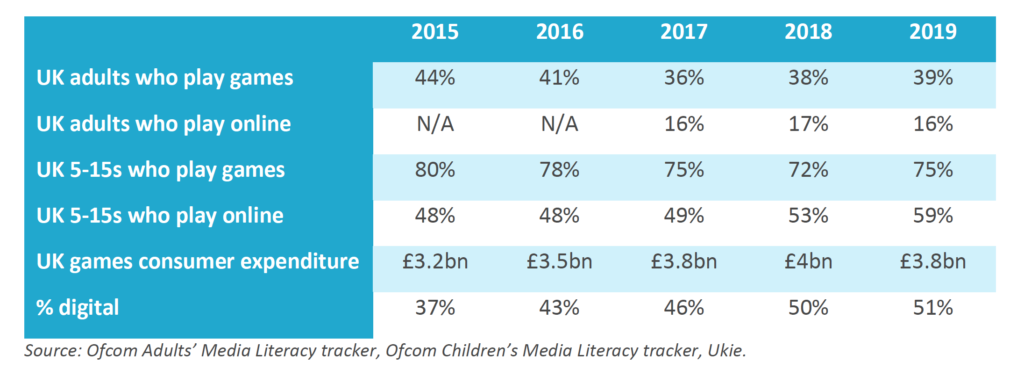
First up is a bit of a shocker. According to the data [1], the number of adults playing games in the UK has actually fallen since 2015. It’s hard to believe from within the gaming bubble, but while the stats show that the numbers playing has risen since 2017, we’re still well down on the 2015 figure of 44 per cent, and broadly the same is true for children and games generally.
Now, you’ll likely be thinking, ‘but my company tells me revenue is up!’ And that’s largely true, there’s certainly been an increase in spending over that period, despite a small dip in last year’s figures. Generally speaking, developers and publishers are doing well. That’s in part down to consistent growth in digital revenue, which while problematic for physical retailers, has improved the profitability of the majority of the industry.
One area that’s seeing consistent growth since 2015 is children playing online games – which often equates to free-to-play titles which are monetised with microtransactions and subscriptions, as we’ll see later.
Obviously, a handful of massive titles are likely to be a big part of this: Minecraft and Fortnite for instance. It’s hard to know whether these players will transition to a broader range of titles over time, or simply stop playing once they lose interest, with the figures from 2020 being skewed by the pandemic it will be a while before we know for sure.
While there’s much to celebrate, the industry may be concerned about the falling numbers of adult gamers. And while that fall may not be equally distributed across all segments (console, mobile and PC), it’s something that needs to be tackled in the longer term, possibly with games that better suit non-core demographics.
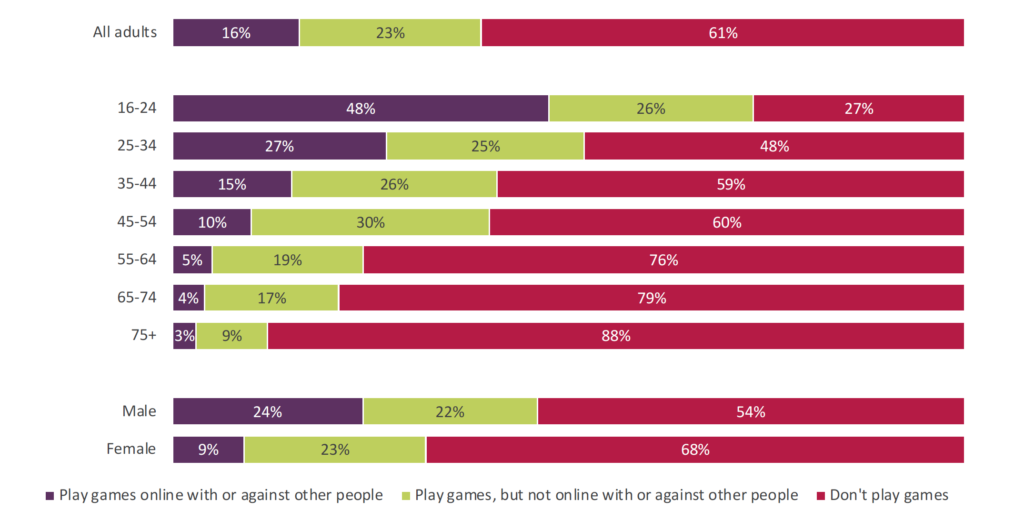
Looking at [2] for instance we can see that while the numbers of people who play games offline is pretty consistent from 16 to 54, the number that play games online with others nearly halves every ten years.
Obviously this chart may look very different in 20 years time, with a young cohort growing up playing well-engineered, easily accessible online games, but the industry can’t presume that’s the case and again must find ways to retain online players, the most engaged of gamers, instead of allowing this pattern of fall off to continue.
It’s unlikely that we’ll ever reach a point where those 75+ are playing as many games as those under 24, but it’s certainly something to aim for.
The other, possibly more worrying statistic here is that while offline games are equally popular with men and women, playing online with other people is far less appealing for women at present. The conventional answer is down to macho and toxic communities, and while that is a factor, my hunch is that most don’t make it that far, that the design and settings of such games fail to appeal to many. Take a look at thatgamecompany’s Sky: Children of the Light for an example of how to design a social, online game that isn’t centred on conflict.
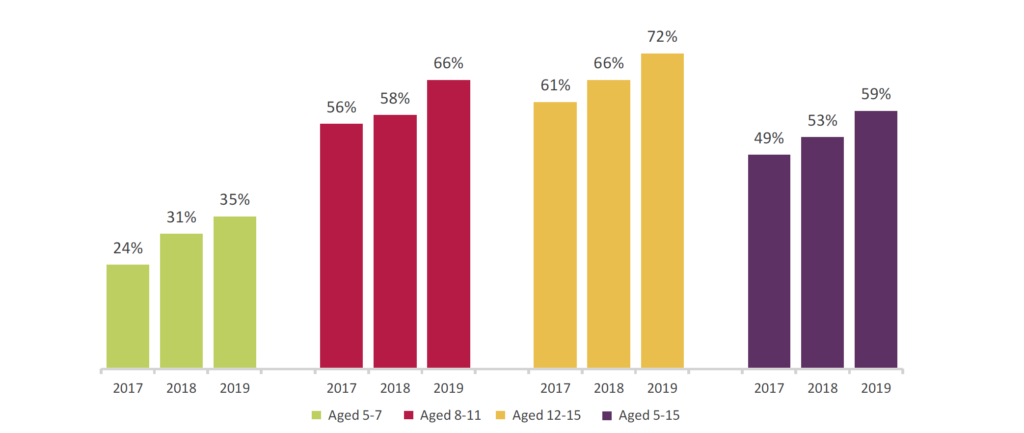
And looking at [3], we can at least see that there’s been consistent growth in the number of children playing online games over the last three years, across all age groups. 72 per cent of 12-15 year olds playing online games is an incredible achievement. Keeping these numbers up, largely by reassuring parents that their children are safe on our platforms, is the key to future success.
ENGENDERING CHANGE
OFCOM’s 2020 research shows the ongoing differences in platform and genre preferences between genders (and yes the data is, disappointingly, a simple binary split).

We can see in [4], the differences in platform preference are generally small among children (aged 8 to 15 in this data), with the 15 per cent difference in console use between boys and girls being the standout figure.
That difference is then reinforced, as the number of women using consoles slumps once they hit eighteen (by 18 points) presumably because many do not buy their own consoles upon leaving the family home. That leaves a 22 per cent console gender gap that persists throughout most of adult life (though it does close again for the over 65s somewhat pleasingly). A similar pattern occurs for PC gaming, starting slightly later at 25.
Looking at genres [4b] we can see that creative games have a standout pattern. They are popular with children but that interest nosedives going into adulthood, we’re presuming that such games are too time consuming or brain-taxing to engage adults as easily. Apart from that we can see that most genres fall in popularity over time, apart from puzzle games, which actually become more popular with age.
Looking at gender divides we can see that competitive games fail to engage women from the very start, so some work to do there potentially, but there are few other standout patterns in the data.
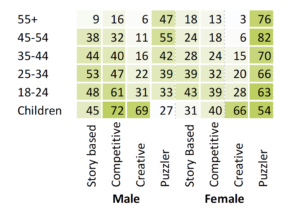
SHOW ME THE MONEY
And so we come around to money. We wish someone would actually ask respondents to estimate how much money they spend on gaming every year, even if answers to such questions are usually fairly unreliable, it would still be interesting to see how much people think they spend on playing games.
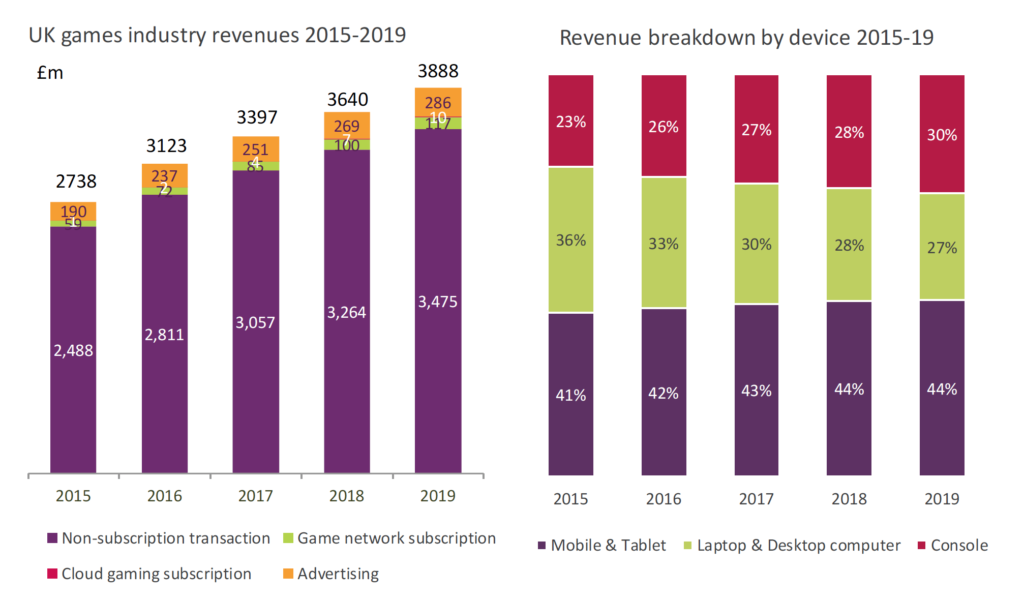
Anyhow, back to the cash. [5] shows a slightly different dataset for online gaming revenues, from PcW, than the Ukie numbers you might be used to, and shows consistent growth over the last four years. Noteworthy is that the vast majority of UK gaming revenues remain transactional – direct purchases by consumers.
That said, there is strong growth in game network subscriptions (17 per cent from 2018 to 2019) that we’d expect to accelerate greatly in the near future. Plus the growth of hyper casual games should push game-based advertising revenue as well. Cloud gaming subscriptions will grow, but also be harder to track in future, with many such solutions being inseparable from the game libraries attached to them – say Game Pass and xCloud.
By platform the notable trend over the past few years is the growth of digital console revenues, as a percentage of a growing total, relative to PC revenues. Cross platform engines and improved digital stores have allowed consoles to better compete in the digital space, with many more games available at more competitive prices than before.
Of course we are seeing here the growing console dominance over the plumpest years of the current generation of hardware plus the incredible success of Switch in a new hybrid hardware segment. But with a smoother than ever next-gen transition (in terms of software compatibility), there’s little reason to expect 2020 to be a fallow transition year as it might have once been. Meanwhile mobile revenues remain remarkably stable.
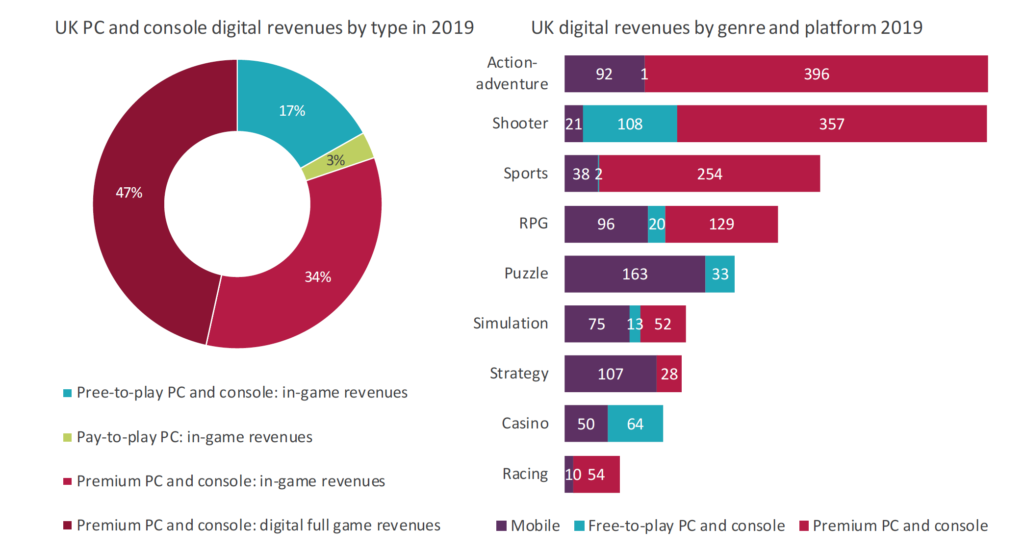
[6] lets us drill down into digital sources of revenues in terms of premium, free-to-play and genres – all based on Nielsen’s Superdata from 2019. And we were surprised that free-to-play console and PC didn’t take a larger slice of the pie, especially in the year of Fortnite’s dominance. What is also interesting is how much in-game revenues in premium games made, think FIFA Ultimate Team, compared to the sale of all digital games as a whole.
Looking at the genre breakdown, we can see that shooter, puzzle and casino titles dominate free-to-play PC and console revenue. While mobile predictably takes big slices in puzzle and strategy, and premium PC and console are most prevalent in action, shooter, sports and RPG.
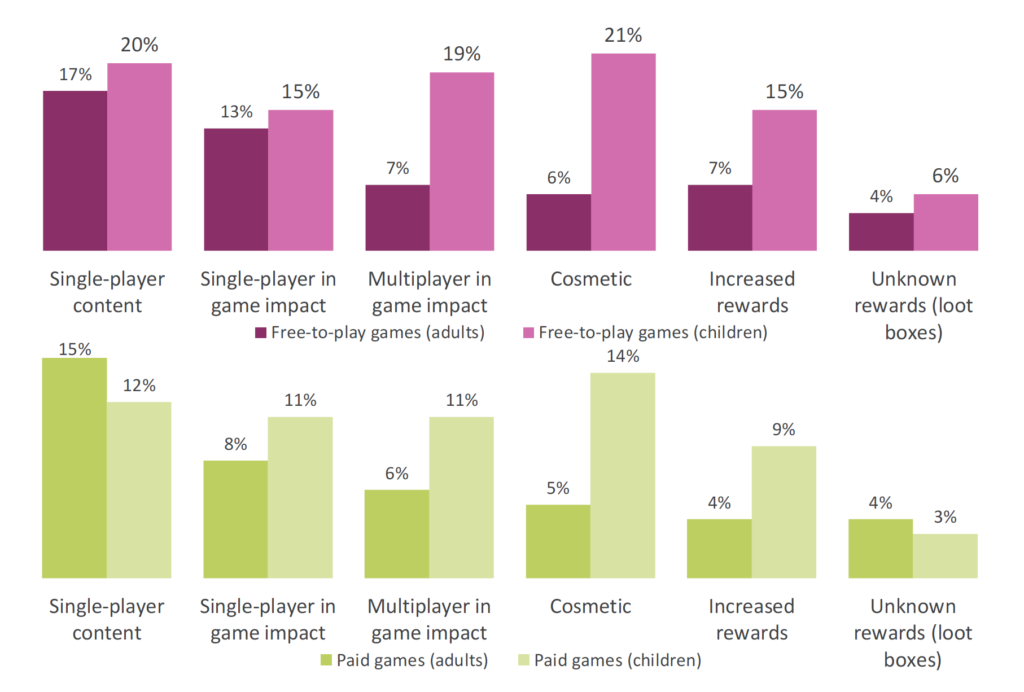
Moving on to [7], new research shows the kind of items consumers buy in-game, something that’s particularly relevant with the House of Lords attacking loot box mechanics this month in its digital harms report.
However, as we suspected, the monetisation strategy is actually rarely taken up by consumers in the UK, with the OFCOM report stating that only a very small percentage
of gamers ever make use of such mechanics.
The report, published last week shows that just four per cent of adults have purchased loot boxes, be that in free-to-play or premium titles. Although that figure rises to six per cent for children playing free-to-play games, surprisingly drops to just 3 per cent for children playing paid games – which would include EA’s FIFA, which regularly comes under attack in tabloid stories on excess spending.
Factoring in the number of children who play games, which OFCOM reckons at 59 per cent for online games as a whole (ages 5-15), and you get around two to four per cent of UK children have bought loot boxes – ever. Whether that’s sufficient to require legislation is above our pay grade, but that’s pretty small potatoes when you consider a recent gambling commission survey noted that 11 per cent of 11-16 year olds said they spent their own money, actually gambling, in the previous week.

Research shown in [8] also notes the fledgling state of games subscription services. While a hefty percentage of gamers (adults and children) have subscriptions to access online multiplayer services (such as Xbox Live Gold etc), only five per cent of adults currently subscribe to a library of games, such as Xbox Game Pass or Apple Arcade, showing the huge potential for growth in the new segment.
ONLINE HARMS
All that talk of spending brings us nicely into a couple of more worrying pieces of data.
Firstly, of 12 to 15 year olds who have experienced spending too much money online, 15 per cent of them did so while gaming. Now that’s not great for the industry, but this is undoubtedly one of the most uncertain pieces of data in the report, with 64 per cent of respondents (these are children remember) being unable to identify the source of their overspending. Still of the clearly identifiable industries, gaming has the biggest chunk and that’s something it will need to work on reducing.
Finally we come to OFCOM’s research into gaming-related harms. The body asked whether those playing games (and using in-game chat) had experienced inappropriate or offensive messages in the last twelve months, and 21 per cent said they had.
While such interactions will never be reduced to zero, especially within highly-stressful competitive games, there’s obviously some work to still be done here, but the problem does not look unsurmountable if 70 per cent of gamers using in-game chat got through a year without issues.
It is sadly likely that many such offensive messages are targeted towards certain groups, though with no breakdown here in the respondents gender or ethnicity we can’t know for sure.
MORE PLEASE
Generally speaking that’s the story of this data, it tells us a lot but still leaves a lot more unanswered. It tells us that the industry is losing women past 18 but doesn’t show exactly why, that creative games are failing to engage enough adults but not where those failings lie. Spending is rising, but the player base appears not to be, and the reasons are another big unknown.
It looks like we’re singing to the choir a little too much still. But the real takeaway here is that the industry, an industry that has access to huge amounts of data, needs to stop looking at numbers and start asking people for the reasons behind the numbers.
It needs to do more research and it needs to share the research it does publicly, or at least within the industry through its trade bodies, so that we can learn more about our problems and work together to fix them.

 MCV/DEVELOP News, events, research and jobs from the games industry
MCV/DEVELOP News, events, research and jobs from the games industry




